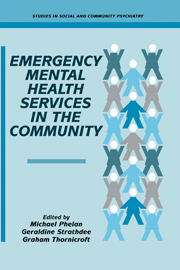Book contents
- Frontmatter
- Contents
- Contributors
- Foreword
- PRINCIPLES AND POLICIES
- CHALLENGE OF IMPLEMENTATION
- 9 Establishing a local emergency service
- 10 Maintaining an emergency service
- 11 Psychiatric emergencies in the casualty department
- 12 Acute crisis respite care
- 13 Family placement schemes as an alternative to short-term hospitalisation
- 14 Acute home-based care and community psychiatry
- 15 Acute day hospital care
- 16 Acute in-patient wards
- 17 The future of mental health emergency services
- Index
10 - Maintaining an emergency service
from CHALLENGE OF IMPLEMENTATION
Published online by Cambridge University Press: 28 October 2009
- Frontmatter
- Contents
- Contributors
- Foreword
- PRINCIPLES AND POLICIES
- CHALLENGE OF IMPLEMENTATION
- 9 Establishing a local emergency service
- 10 Maintaining an emergency service
- 11 Psychiatric emergencies in the casualty department
- 12 Acute crisis respite care
- 13 Family placement schemes as an alternative to short-term hospitalisation
- 14 Acute home-based care and community psychiatry
- 15 Acute day hospital care
- 16 Acute in-patient wards
- 17 The future of mental health emergency services
- Index
Summary
Although there is now overwheliming evidence that psychiatric services concentrating on rapid response in community settings are superior to more conventional services (Stein & Test, 1980; Dean & Gadd, 1990; Merson et al., 1992; Burns et al., 1993) there is still scepticism about the feasibility of organising rapid services nationally. Much of this concern appears to focus on the phenomenon of burn-out; teams work well for a time (usually when research is being undertaken on the service), but then a state of despondency and poor morale develops, the team breaks up and enthusiasm is lost (Dedman, 1993). If this was indeed a common state of affairs it would nullify a large part of the research evidence to date. Above all, service research has to be applicable to practice, and if the findings are only applicable under certain circumstances we need to know exactly what these circumstances are. In this chapter I will argue that burn-out is an unsatisfactory term used to describe a range of difficulties experienced by psychiatric teams involved in caring for those with severe mental illness, of which the strain imposed by direct patient care is only one. Many of the others can be overcome.
Most of my recent experience is based on working in the Early Intervention Service (EIS), a community-based service set up as a demonstration project by the Department of Health in 1987 to provide a rapid response service for patients with severe mental illness.
- Type
- Chapter
- Information
- Emergency Mental Health Services in the Community , pp. 197 - 212Publisher: Cambridge University PressPrint publication year: 1995
- 1
- Cited by



